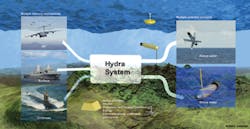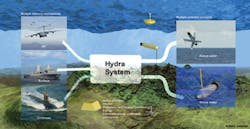DARPA releases BAA for unmanned submersible mothership able to launch UAVs and UUVs
ARLINGTON, Va.-U.S. military researchers released an industry solicitation to develop an unmanned submersible over the next five years that can transport and deploy unmanned aerial vehicles (UAVs) and unmanned underwater vehicles (UUVs) stealthily close to enemy operations.
Unmanned vehicles designers at the U.S. Defense Advanced Research Projects Agency (DARPA) in Arlington, Va., released a broad agency announcement (DARPA-BAA-13-39) for the Hydra program to demonstrate an unmanned undersea system with a new kind of unmanned-vehicle delivery system that inserts UAVs and UUVs stealthily into operational environments to respond quickly to situations around the world.
Hydra aims to develop a distributed undersea network of UUVs and UAVs able to operate independently for weeks or months at a time to complement manned ships, submarines, and aircraft as an alternate means of delivering various capabilities above, on, and below the ocean's surface.
Key to the Hydra project will be developing modular payloads for intelligence, surveillance, and reconnaissance (ISR), mine counter-measures (MCM), and other important capabilities.
The Hydra large UUV is to use modular payloads inside a standardized enclosure to deploy a mix of UAVs and UUVs, depending on the military situation. Hydra will integrate existing and emerging technologies in new ways to create an alternate means of delivering a variety of payloads close to where they're needed, DARPA officials say.
The Hydra program also will seek to demonstrate not only the unmanned vehicle mothership, but also examples of the UAVs and UUVs that could be carried into battle covertly. Companies are being asked to submit proposals by October.
The rising number of ungoverned states, piracy, and proliferation of sophisticated defenses severely stretches current resources and influences U.S. military capability to conduct special operations and contingency missions, DARPA scientists say.
The Hydra program represents a way to add undersea capacity that can be tailored to support each mission. Technologies are to be adaptable to several different delivery options, including airborne, surface, and subsurface. The Hydra program could enable other new capabilities not currently performed from undersea, DARPA officials explain. The program will demonstrate individual high-risk components and systems before the military commits to a specific full-system approach, and refine technologies prior to operational demonstrations of the UAV and UUV payloads.
Hydra will have three phases. First, the program will define concepts, develop component capabilities, and reduce subsystem risks with one or more contracts in several technical areas. Later, the program will develop and test a full system. Technical areas involve modular enclosures, air vehicle payloads, undersea payloads, concepts of operation, and supporting technologies.
Modular enclosures will host Hydra payloads and provide a means to transport, house, and launch them. It will be a payload-agnostic "mission truck" that will provide basic services and support to individual payloads. It will operate in shallow coastal waters and harbors for extended periods.
Subsystems will include ballast system, energy, communications, command and control, propulsion, the ability to accommodate different payloads, and measures for long-duration submerged operations. It will deploy its UAVs and UUVs without surfacing, and maintain communications throughout its mission.
The UAV payload will feature encapsulated air vehicles that fit into the standard Hydra modular enclosure. The air vehicle payload that will be ejected from the mothership, float to the surface, launch, fly a minimum range, and conduct several different types of missions.
Undersea payloads will launch, dock, and recharge from the mothership and collect intelligence information. After their missions, they will download information to the mothership, which will communicate it to command authorities.
Concepts of operation will involve Hydra deployment and retrieval using submarines and transport aircraft; command, control, and communications architectures; and the potential effectiveness of Hydra UAV and UUV payloads.

